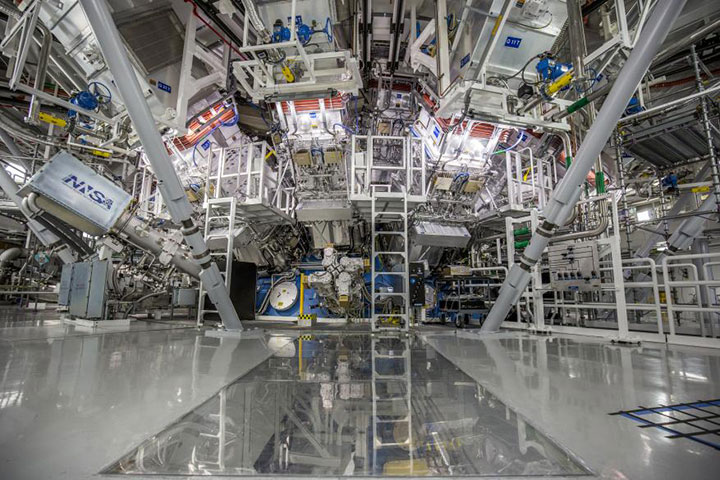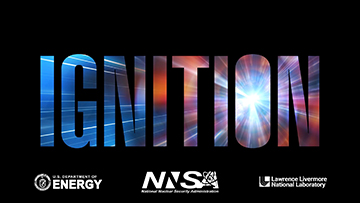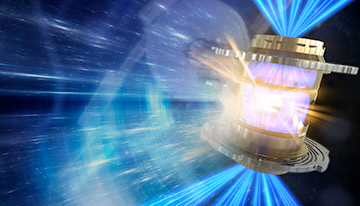
The target chamber of LLNL’s National Ignition Facility (NIF). On 5 December 2022, 192 laser beams delivered 2.05 megajoules (MJ) of energy to a tiny fuel pellet to create the first fusion reaction that produced more energy than it consumed. [Image: LLNL]
In the decades-long quest for energy from nuclear fusion, two main approaches have vied for the crown. In one, magnetic-confinement fusion (MCF), the fusion magic would happen in plasmas held in place by powerful magnetic fields in large, donut-shaped facilities called tokamaks. In the other, inertial-confinement fusion (ICF), intense beams, usually from a laser, would pour energy into tiny fuel pellets, eventually leading to implosion and thermonuclear fusion in the payload.
An elusive milestone for both the MCF and ICF approaches, though, has been actual ignition—the production of more energy from fusion than the energy used to drive the reaction. And workers on both approaches have poured years of their own energy into solving this problem, a necessary first step toward developing a practical fusion power source.
Round one, it appears, now has gone to the lasers. The National Ignition Facility (NIF) of the Lawrence Livermore National Laboratory (LLNL), CA, USA, has announced that, in a landmark experiment on 5 December 2022, it demonstrated the first instance of controlled fusion that produced more energy than the laser energy used to drive it.
The achievement—as noted by US Secretary of Energy Jennifer Granholm at a press conference where it was announced—culminates some six decades of anticipation since the prospect of laser-induced fusion was first envisioned, as well as nearly three decades of long-term, practical commitment and effort since NIF’s construction began in 1994. Notwithstanding the significant scientific accomplishment, however, it may be decades more before the fire lit at NIF last week results in a workable approach to fusion energy.
A shot heard round the world
In NIF’s experiments, light from 192 high-energy laser beams is focused onto a hohlraum—a small gold cavity that contains a BB-sized fuel pellet made of two flavors of cryogenically frozen “heavy hydrogen,” deuterium and tritium. The lasers heat the hohlraum inner surface, generating X-rays that pressurize and heat up the fuel pellet, and that cause the outer shell of the pellet to blast away. Dutifully following Newton’s third law, the remainder of the pellet implodes as a result, enabling fusion of the hydrogen payload.
Schematic of NIF experiment setup (from OPN, “Laser Fusion: The Uncertain Road to Ignition,” September 2014). [Infographic: Phil Saunders] [Enlarge Image]
That, at least, is how it’s supposed to work. But while the large team of scientists and engineers at NIF has made steady progress toward ignition, particularly in the past several years, the goal has remained stubbornly out of reach. The most recent previously released result, in August 2021, brought the facility to 70% of the energy-breakeven level that would have signaled ignition.
Then, at 1:03 a.m. on Monday, 5 December 2022, came the shot heard round the world.
“We had high hopes for this one,” Michael Stadermann, the program manager for target preparation, said in a panel discussion after the press announcement. And as the team reviewed the data from the early-morning shot, it realized that the hopes were justified. The NIF lasers had pumped 2.05 megajoules (MJ) of energy into the hohlraum. And multiple lines of evidence—mainly involving counts of neutrons generated in the reaction—indicated that 3.15 MJ of fusion-derived energy had come out, a gain of more than 50%.
Painstaking effort

[Image: Courtesy of LLNL]
The NIF team’s high hopes stemmed in part from extensive work to refine its approach after the August 2021 burn. Part of that effort, noted principal designer Annie Kritcher, involved tuning the shape of the laser pulse to deliver its energy most efficiently. “We don't just smack the target with all of the laser energy all at once,” she said. “We define very specific powers at very specific times to achieve the desired conditions.”
The effort to improve the approach looked at the details of the target as well. Stadermann noted, for example, that pits and holes in the fuel capsule “smaller than bacteria” can potentially affect the experiment. While such flaws can’t be eliminated entirely, their potential impact needs to be thoroughly understood for a successful experimental design.
The team also took steps to make the target more perfectly spherical, for a more symmetrical implosion, and to give it a somewhat thicker shell—to “give us more margin for achieving ignition when we have non-optimal … conditions,” according to Kritcher. Further, she noted that the team has started to leverage machine-learning techniques to test out its designs and confirm that they are robust.
Finally, the successful result hinged on continual improvements to the laser system and optics that ultimately drive and determine the experiment. “Thanks to continued investment from the nation,” said Jean-Michel Di Nicola, the chief engineer for NIF’s laser systems “we have been able to deliver 8% more energy on the experiments last week” compared with the August 2021 experiments, which helped tip the scale. And, he said, “in the future with sustained and upgraded investment, the NIF laser could produce even higher energies and power,” potentially enabling higher fusion yields. Such gains in laser power also have required, and spurred, exceptional work at NIF and other facilities on the supporting optics, and on protecting optical materials from damage.
Long, difficult road to fusion energy
Strictly speaking, NIF—the world’s largest laser, occupying a complex the size of three football fields—was not intended for developing a new energy source. Instead, its nominal mission is to support “stockpile stewardship” of the US nuclear arsenal, by simulating the conditions at the heart of nuclear weapons without actually blowing them up. Even so, at a time of looming climate change and instability in energy markets, the minds of both the panelists at the press conference and the public at large clearly have been preoccupied with what the result means for the development of fusion energy.
The Biden administration has articulated what several speakers at the press conference called “a bold decadal vision” for achieving commercial fusion power within ten years, with nice recent chunks of funding to help. But the director of LLNL, Kim Budil, was careful to manage expectations, citing “very significant hurdles” to commercialization, “not just in the science but the technology.”
“So probably not six decades, not five decades,” Budil said. “But with concerted effort and investment, a few decades of research on the underlying technologies could put us in a position to build a power plant.”
One key issue to overcome is the so-called wallplug efficiency. While the laser pulse that impinged upon the hohlraum had an energy of only 2.05 MJ, Budil acknowledged that the NIF laser needed to draw a whopping 300 MJ from the wall to ultimately create that 2.05-MJ pulse and generate 3.15-MJ of fusion energy yield. The laser at present also can fire only once a day, at a single target.
Those inefficiencies clearly would constitute a non-starter for designing any production-ready fusion energy system. However, Budil also pointed out that the NIF laser is “built foundationally on 1980s laser technology.” Advances in diode pump sources, repetition rates and other parameters since then could make a laser-based fusion system look a lot more feasible.

A key issue for a future laser power plant would be scaling up the manufacture of the fuel pellets at the heart of the reaction. [Image: John Jett and Jake Long / LLNL]
Other issues for laser fusion at scale relate to the creation of a supply of the deuterium–tritium fuel capsules. In the panel discussion, Stadermann noted that, while it “only takes about two weeks” to actually manufacture a capsule for one of the NIF experiments, it takes around seven months of work from initial design to delivery. “The targets we’re using are designed for science … to be able to see what’s going on,” he said. “These targets are not designed for fusion energy.”
Moving to a workable laser fusion energy scheme, by contrast, would require a system for producing millions of such identical target capsules every day. It would also require the creation of an approach for “breeding” new tritium atoms in the target chamber and capturing them for use as fuel, since tritium is very rare indeed—only around 17 kg of the stuff exists on planet Earth.
A “Wright Brothers” moment for fusion?
It is, of course, unfair to hang these and other potential stumbling blocks for commercial fusion around NIF’s neck. As several at the press announcement pointed out, NIF was not built as a commercial fusion-power prototype, but as a scientific facility. And the scientific achievement of fusion ignition—essentially, showing that it can be done at all—is, unarguably, a crucial milestone in any workable long-term approach to fusion energy.
In a phone call with Optica, Michael Campbell, a former director of the University of Rochester Laboratory of Laser Energetics, NY, USA, and the first program manager at NIF, summed up the significance by alluding to another technological fulcrum more than a century ago.
“People have been working on fusion since the early 1950s, [and] this is the first time a plasma has produced more fusion energy than was required to heat and confine it,” said Campbell. “This is the Wright Brothers moment for fusion.”


